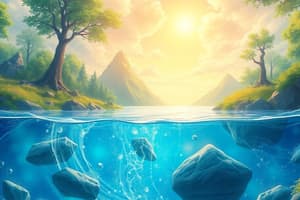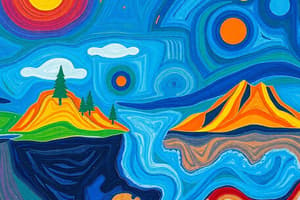Podcast
Questions and Answers
Which of the following statements accurately describes the distribution of Earth's water?
Which of the following statements accurately describes the distribution of Earth's water?
- The distribution of water is equal, with oceans, fresh water reserves, atmosphere and living organisms having similar amounts.
- Oceans hold the largest percentage of Earth's water, with freshwater primarily stored in glaciers and ice caps. (correct)
- The majority of freshwater is readily accessible as surface water, such as in lakes and rivers.
- Freshwater constitutes the majority (over 90%) of Earth's total water reserves.
Which of the following processes primarily drives the movement of water from the Earth's surface into the atmosphere?
Which of the following processes primarily drives the movement of water from the Earth's surface into the atmosphere?
- Sublimation
- Condensation
- Infiltration
- Evapotranspiration (correct)
How do small and large water cycles differ in the hydrological cycle?
How do small and large water cycles differ in the hydrological cycle?
- Small water cycles occur exclusively over land or water, whereas large water cycles involve water exchange between oceans and land. (correct)
- Small water cycles involve the exchange of ocean water between continents, unlike large water cycles.
- Large water cycles focus on surface water, while small water cycles involve underground water.
- Large water cycles happen more quickly than small water cycles.
Which of the following is NOT a primary factor contributing to the formation of endorheic basins?
Which of the following is NOT a primary factor contributing to the formation of endorheic basins?
Considering the components of the hydrosphere, what role do living organisms play?
Considering the components of the hydrosphere, what role do living organisms play?
Which of the following regions would most likely be classified as an endorheic basin?
Which of the following regions would most likely be classified as an endorheic basin?
What is the primary distinction between hydrography and hydrogeology as disciplines studying the hydrosphere?
What is the primary distinction between hydrography and hydrogeology as disciplines studying the hydrosphere?
If a large area experiences increased deforestation, what would be the most likely impact on the local water cycle?
If a large area experiences increased deforestation, what would be the most likely impact on the local water cycle?
How does oceanography contribute to our understanding of the hydrosphere's dynamics?
How does oceanography contribute to our understanding of the hydrosphere's dynamics?
How does the concept of the 'water cycle' relate to the distribution and availability of freshwater resources?
How does the concept of the 'water cycle' relate to the distribution and availability of freshwater resources?
Flashcards
Hydrosphere
Hydrosphere
The water part of the Earth, including surface, subsurface water, atmospheric water, and water in living organisms.
Water Cycle
Water Cycle
The continuous movement of water on, above, and below the surface of the Earth.
Large Water Cycle
Large Water Cycle
Water exchange between the ocean and land
Small Water Cycle
Small Water Cycle
Signup and view all the flashcards
Endorheic areas
Endorheic areas
Signup and view all the flashcards
Hydrology
Hydrology
Signup and view all the flashcards
Hydrogeology
Hydrogeology
Signup and view all the flashcards
Hydrography
Hydrography
Signup and view all the flashcards
Hydrogeography
Hydrogeography
Signup and view all the flashcards
Oceanography
Oceanography
Signup and view all the flashcards
Study Notes
- Hydrosphere refers to the water envelope of Earth
- It includes all surface and subsurface water, atmospheric water, and water in living organisms
- Oceans contain the majority of Earth's water
Composition of Water
- Oceans make up 97% of Earth's water
- Only about 3% is fresh water, with 2% of that being glaciers
Hydrological Science Fields
- Hydrology
- Hydrogeology
- Hydrography
- Hydrogeography
- Oceanography/Oceanology
Water Cycle
- The water cycle is a continuous, never-ending process
- The water cycle ensures constant movement of water on Earth
Types of Water Circulation
- Large cycle: water exchange between ocean and land
- Small cycle: water exchange only over land or only over the ocean
Steps of the Water Cycle
- Evaporation initiates the cycle
- Moisture enters the atmosphere, leading to cloud formation and precipitation
- Atmospheric precipitation returns water to the surface
- Water either soaks into the ground or flows off land via rivers
Water Cycle Details
- Most water that evaporates from oceans returns to them as precipitation
Endorheic Basins
- Endorheic basins are areas from which water does not drain into seas or oceans
- They cover a large portion of the land, i.e., more than 20% of the land area (approximately 32 million sq km)
Water Dynamics in Endorheic Areas
- In endorheic regions, evaporation and infiltration outweigh atmospheric precipitation
Conditions for Endorheic Basins
- Endorheic basins are often deserts, semi-deserts, salt pans, or mountainous regions
- e.g. Sahara, Kalahari, parts of Australia and some mountain regions
Examples of Endorheic Areas
- e.g. Caspian Sea, Aral Sea, Lake Balkhash (Kazakhstan), Iranian Highlands, Great Basin (USA), Arabian Peninsula, Dead Sea
Studying That Suits You
Use AI to generate personalized quizzes and flashcards to suit your learning preferences.




